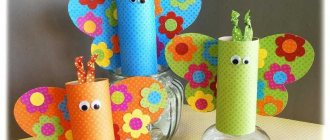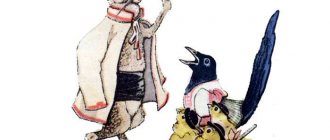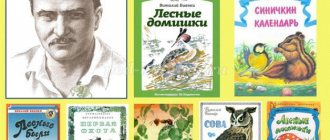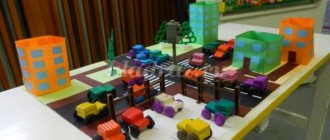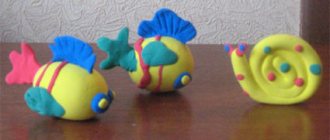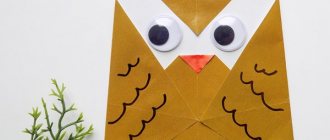Abstract of the GCD on artistic creativity (modeling) “Rays for the sun”
Goal: developing skills in working with plasticine, awakening interest in modeling.
Tasks:
1. Improve children’s ability to roll a piece of plasticine using circular movements of the palms, giving it a spherical shape. 2. Teach the technique of flattening a ball on a horizontal surface to obtain a flat image of the original shape. 3. Strengthen the children’s ability to separate small lumps from a large piece of plasticine and roll them between their palms with direct movements of both hands. 4. Develop the ability to navigate on a sheet of paper. 5. Develop fine motor skills. 6. To cultivate in children responsiveness, kindness, the ability to sympathize with characters, and the desire to help them.
Materials for the lesson:
• thick cardboard of light blue color with silhouettes of a bee, bird, hare, rooster, size 1\2 A4; • plasticine of yellow, red, orange colors; • hand wipe; • modeling board.
Progress of the lesson
1. Organizational part.
The teacher offers to guess the riddle.
Who gets up earlier than everyone else in the morning? Who gives everyone warmth and light? (Sun.)
The teacher shows a picture of the sun.
- Right. The sun wakes up before everyone else, washes itself from the clouds to be clean, and then rises high into the sky.
The cloud hides behind the forest, The sun looks from the sky and is so pure, kind, radiant. If we could get him, we would kiss him!
- Guys, look how sunny it is? (Round) Children, following the teacher, draw the sun in the air with their fingers. - And its rays are straight, like our hands. You and I have two hands, but how many rays does the sun have? (A lot.) What sunshine? (Children's answers...), And what are the rays of the sun? (Children's answers...), How many rays does the sun have? (Children's answers...). That's right, a lot. — The sun’s rays are everywhere: from the side, above, and below. He needs a lot of rays to warm everyone, to illuminate everyone with a bright light, to wake them up in the morning - flowers, birds, bunnies and squirrels, boys and girls. This is how good our sun is! But one day the sun did not come out into the sky. It was a cloudy and gloomy morning. Apparently the sun is not well, he does not have the strength to open his eyes and illuminate the earth with light. And the animals and birds became sad that they could no longer play and have fun. You and I will have to help out our friends while the sun is sick. But what are we going to make it from? Guys, look, I have plasticine, you and I can make our sun using plasticine. To make the sun look like a real one, let's remember what it is like. (Round.). And what else does our sun (Rays) have? What color could it be? (Red, yellow, orange).
2. Practical part.
Children can choose from red, yellow or orange plasticine. Place one part between your palms and roll the ball in a circular motion from left to right, pressing on it with your palm. Place the finished ball in the middle of the cardboard and lightly press on it to flatten it.
Finger gymnastics (after attaching the sun, children clench their fingers into a fist and unclench them, 3-4 times)
They applied and pressed, Our hands did not get tired.
Pinch off a small piece from the second part, place it between your palms and roll the sausage with straight movements of both hands. The resulting ray-column is attached to the sun, pointing it at a bee or bunny, lightly pressing it against the picture along the entire length of the ray. Make the remaining rays in the same way.
Finger gymnastics (after attaching several rays, children clench their fingers into a fist and unclench them, 3-4 times)
They applied and pressed, Our hands did not get tired.
- Look how light it has become in our room! It is your suns that shine so brightly. Guys, in the picture the sun has woken up and invites you to play with it.
3. Final part
Children perform the motor exercise “The sun rose in the morning.”
The sun rose in the morning (Stretching.) And went for a walk (Walking in place.) And on our street he liked everything (Tilts his head left and right.) The sun ran along the golden path. (Running in a circle.) And the sun came straight into our window. (Folding hands into a “window” shape.) Together we went with the sun to kindergarten. (Walking in a circle.) The sun caressed all the children at once. (Stroking himself on the head.)
- What a wonderful, kind sun! I stroked all the guys so that you grow up strong, healthy and kind, like the sun.
The teacher takes turns patting all the children on the head, calling each one by name.
Author: Gafarova Rimma Zainagatdinovna, teacher, MBDOU d/s “Belochka”, Kamensk-Uralsky, Sverdlovsk region, Russia
The article is published in the author's edition
Summary of a lesson on modeling with children of primary preschool age “Sun for animals”
Municipal preschool educational institution
combined kindergarten No. 390
ABSTRACT
modeling classes for preschool children
"Sunshine for animals"
Author-developer:
teacher Shuvalova Nina Mikhailovna
Nizhny Novgorod
2010
SUMMARY OF THE CLASS ON STYLE “SUN FOR ANIMALS” /2 JUNIOR GROUP!
OBJECTIVES: EDUCATIONAL. Teach children
convey the image of the sun in a plastic way, using the technique of smoothing plasticine along the contour. Strengthen the ability to roll out plasticine with straight movements, creating rays. DEVELOPMENTAL. Develop and strengthen fine motor skills of the hands. To develop aesthetic perception in children. EDUCATIONAL. To create in children an emotional attitude towards the poetic image. To foster in children a sense of empathy for the characters and a desire to help them. PRELIMINARY WORK. Reading K. Chukovsky’s fairy tale “The Stolen Sun”, looking at illustrations depicting the sun. Drawing the sun with colored pencils and paints. Conversations with children about fairy tale characters. MATERIAL FOR THE CLASS. For the teacher, illustrations for a fairy tale: sun, cloud, hare, sparrow. Outline of the sun on blue cardstock for display. For children - sheets of blue cardboard with an outline of the sun, yellow plasticine.
PROGRESS OF THE CLASS. 1. Preliminary conversation. Children sit around the teacher on the carpet.
The teacher reads to the children an excerpt from K. Chukovsky’s fairy tale “The Stolen Sun”, showing the corresponding illustrations. The sun walked across the sky and ran behind a cloud. The bunny looked out the window. It became dark for the bunny. The gray sparrow is crying. Come out, sunshine, quickly! We feel sad without the sun. We can’t see a grain in a field. The teacher asks the children what the animals should do now without the sun, inviting the children to join in the discussion of what they read. Next, the teacher asks the children to remember who helped save the sun? The teacher tells the children that the bear that saved the sun cannot help us because it is looking for its cubs. Children offer to help the animals themselves. The sun can be drawn with paints or pencils. You can also cut out the sun from colored paper and give it to animals. The teacher listens carefully to the children's advice, praises them for their resourcefulness and desire to help, and invites the children to go look for the sun. 2. PHYSICAL CLASS In the morning the sun rises Higher, higher, higher. By night the sun will set Lower, lower, lower. Okay, okay, Sunny is laughing. And under the sun everyone sings merrily. After the game, the teacher takes out the sun - a ready-made sample - and invites the children to go to the tables.
3. RESEARCH ACTIVITIES. The teacher offers to look at a sample of the sun. With the help of questions, children determine the shape of the sun, what parts it consists of./circle, sticks-rays./ Next, the children name the color, with the help of the teacher they draw conclusions why the sun is yellow. The color is warm, so it warms everyone up. Then the teacher suggests looking at the contours of the sun laid out on the tables. The teacher asks the children to run their finger along the outline in order to visually and visually remember the shape of the sun. Next, children are asked to move their finger from the contour to the center of the circle, explaining this by saying that so that the sun does not lose the shape of the circle, they should not go beyond the contour line with their finger. After finger research, the teacher reminds the children how to use plasticine when doing work (pinch off small pieces from a large one and smooth them evenly from the outline to the center.) Then the children, together with the teacher, remember rolling out the plasticine with straight movements (sausages) for rays. 4. PRACTICAL ACTIVITY. After all the research and explanations, the teacher invites the children to start working on their own. During independent activities, the teacher encourages children and helps unsure children. At the end of the lesson, the teacher praises the children for their work and reads an excerpt from the fairy tale: The bunnies and squirrels are happy, the boys and girls are happy. Well, thank you guys for the sunshine. The bunny and the sparrow thank the children for the beautiful sunshine and invite the children for a walk. 5
.FOLLOW-UP WORK. After classes, in your free time, offer the children the didactic game “Feed the Hare and the Sparrow.”
Literature.
- Berseneva G.K. Textile. Dough. Paper. Homemade crafts. M.: Astrel Publishing House LLC: AST Publishing House LLC, 2001.
- Dankevich E.V. We make it from salt dough. St. Petersburg: Publishing House "Crystal", 2001.
- Kiscalt Isolde. Salty dough. M.: AST-PRESS, 2001.
- Kozlina A.V. Manual labor lessons. M.: Mosaic-Synthesis.
- Komarova T.S., Savenkov A.I. Collective creativity of children. M.: Pedagogical Society of Russia, 2000.
- Khalezova N.B. and others. Modeling in kindergarten: a book for kindergarten teachers. M.: Education, 1986.
- Khalezova N.B. Folk sculpture and decorative modeling in kindergarten: A manual for teachers. M.: Education, 1984
- Sensorimotor development of preschool children in fine arts classes. Bezrukikh M.M. 2001
- "Childhood. Program for the development and education of children in kindergarten." V.I. Loginova, T.I. Babaeva
- Raising a child’s sensory culture” L.A. Venger, E.G. Pilyugina
- “Theory and methodology of visual activity in kindergarten” V.B. Kosminskaya, E.I. Vasilyeva
Summary of a comprehensive lesson on modeling from salt dough and speech development in the middle group of a preschool educational institution
Summary of a comprehensive lesson on modeling from salt dough and speech development in the middle group “Sun of Kindness”
Goal:
- Fostering kindness, humanity and attentive attitude towards each other.
— Development of fine motor skills of the hands during visual activities. Objectives:
- Define the concepts of good in the process of communication.
— Expand children’s knowledge about kindness and its role in human life. — To foster in children friendly relationships, feelings of self-esteem and respect for others. — To develop children’s interest in working with salt dough. — Strengthen the skill of modeling salt dough. — Improve the ability to roll the dough between your palms, giving it the shape of a ball, and roll sausages. — Cultivate accuracy and perseverance. Preliminary work:
— Reading fairy tales.
— Conversations about good and bad deeds, — D. game “Mom’s Helpers.” Material:
- Book with the story “The Stolen Sun” by K. Chukovsky. — Pictures of the sun. - Colored salt dough (Yellow, black, pink) - Work napkin, a stack for each child.
Progress of the lesson:
Educator: Hello, children! Children:
Hello!
Educator: Even though it’s frosty today, look how brightly the sun is shining outside, let’s take a look. (Go to the window and look at the sun). (Answers to children’s questions about the landscape outside the window) Educator: Now let’s go to our seats: All the children have gathered in a circle. I am your friend and you are my friend. Let’s hold hands tightly and smile at each other. Let’s turn to each other, smile and hug.
And now I will read you the story “The Stolen Sun”. (Reading a story, talking about the plot) Physical education. This is how the sun rises, Higher, higher, higher. (Raise your hands up. Stretch) By night the sun will set Lower, lower, lower. (Squat down. Place your hands on the floor) Okay, okay, Sunny is laughing. And we live happily under the sun. (Clap your hands. Smile)
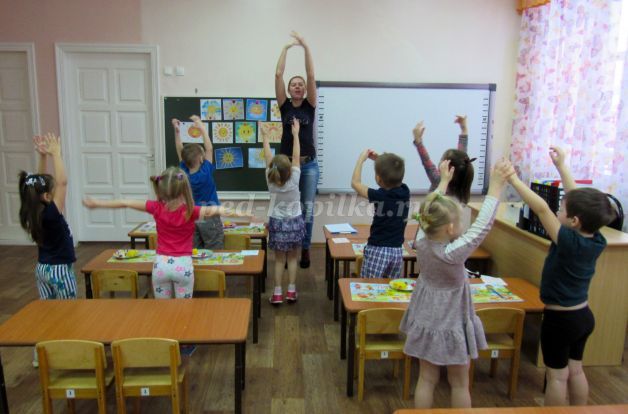
Educator: Now take the dough in your hands, is it soft? Children:
Yes!
Educator: What does it remind us of? Children:
Plasticine!
Educator: Well done, right! Let us remember him. Finger gymnastics “Bake pies” Mnemple, mnem, mnemple the dough! (the child alternately “presses” the imaginary dough with his fists) Press the dough, press it, press it! (sharply clenches his fingers into fists and unclenches them, first simultaneously, then alternately) We will bake pies! (we “make” pies with our hands, as if transferring from one palm to another).
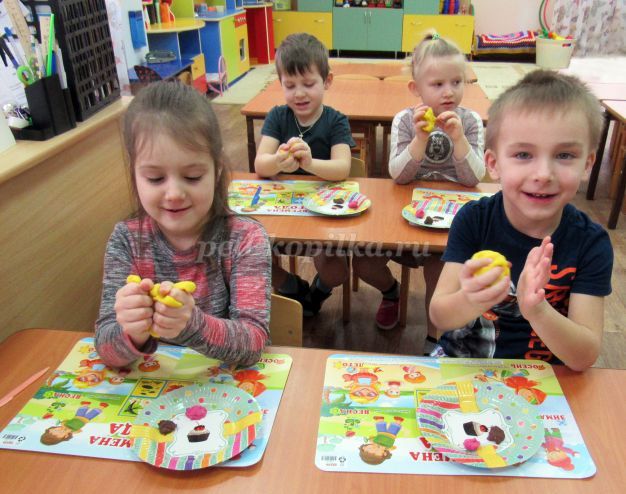
(Put all the work on one table so that everyone can admire each other’s work.) Educator: Children, what a great job you are, you all did your best! Let's remember what we did in today's lesson? (Children's answers) Educator: Well done!
Thank you, class is over. Application. Practical part of the lesson
Modeling from salt dough “Sun of Kindness”
Step-by-step instructions: 1. Make the sun. Take the yellow dough and cut off a piece of it with a stack.
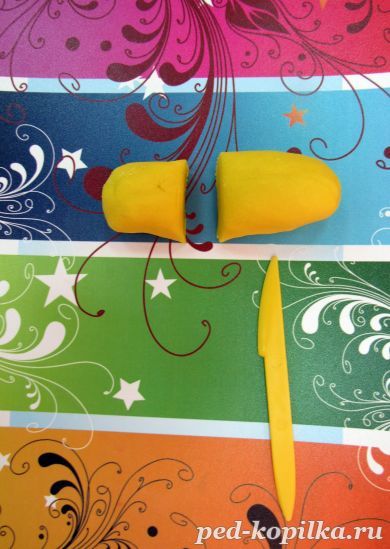
2. Roll the cut portion of the dough between your palms, giving it the shape of a ball. Place the resulting ball on a previously prepared white sheet of paper and press it slightly with your palm.
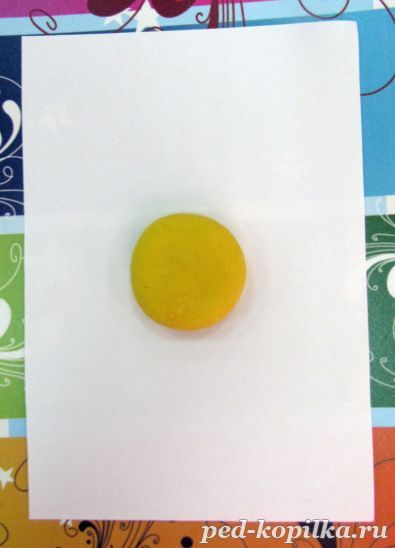
3. Make rays. Cut a piece from the remaining dough, roll it into a sausage with your palms and place it in the sun.
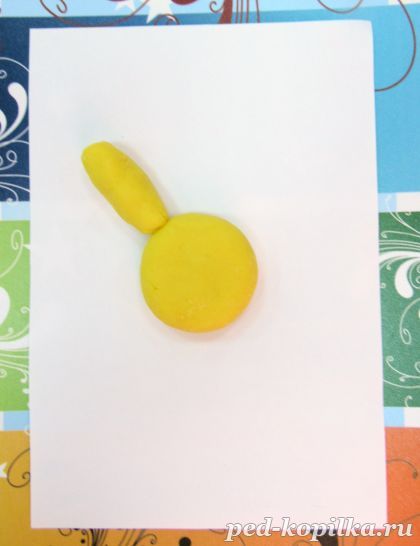
4. Roll sausages from all the remaining dough.
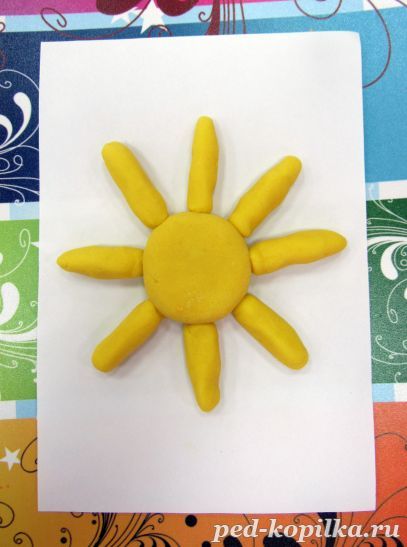
5. Making eyes. Take black dough and roll into circles. Place the resulting circles in the sun and gently press them with your finger.
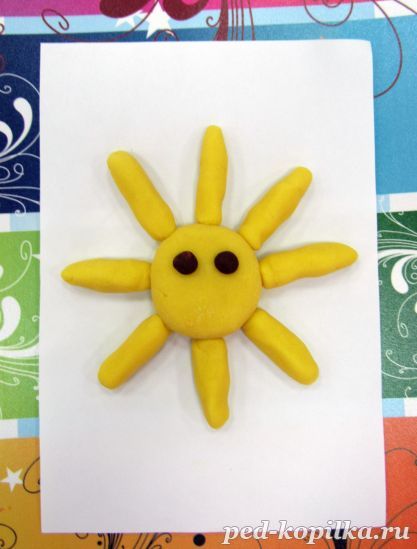
6. Make a mouth. Take the pink dough and roll it into a sausage. Place the resulting dough sausage in the sun and gently press it in.
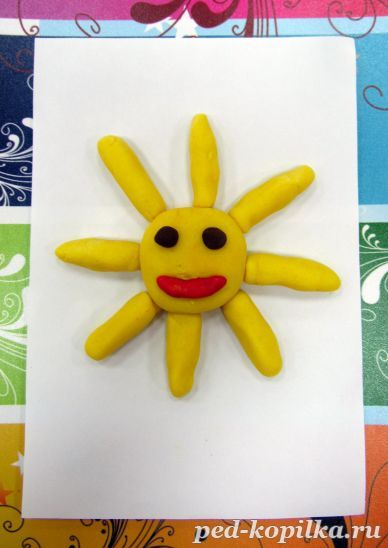
We recommend watching:
Synopsis of cognitive direct educational activities in the middle group Integrated lesson in the middle group Synopsis of educational activities in the middle group. Non-traditional drawing technique Synopsis of an integrated modeling lesson for middle group children. Penguin
Similar articles:
Summary of an integrated lesson in a middle group on the topic “How to find a path”
Abstract of OD on plasticineography in kindergarten in the senior group. Theme "Sun"
Abstract of OD on plasticineography in the senior group on the topic “Radiant Sun”
Description of the material: I offer you a summary of OD on plasticineography for children of the senior group (5-6 years old) on the topic “Radiant Sun.” The material will be useful to teachers of the senior group of preschool educational institutions. This is a summary of an artistic and aesthetic activity aimed at developing the creative abilities of preschool children through plasticineography. Abstract of OD on plasticineography in the senior group on the topic “Radiant Sun” Integration of educational areas: “Cognition”, “Communication”, “Socialization”, “Artistic and aesthetic creativity”, “Reading fiction”. Goal: To teach children to convey the image of the sun in a plastic way, using the technique of smoothing plasticine along the contour. Objectives: Educational: • To consolidate the ability to roll out plasticine with straight movements, creating rays. • Teach children to convey an image in a plastic way, using the technique of smoothing plasticine along the contour. • Introduce a new method of depiction - plasticineography, leading children to create an expressive image through volume and color. • Learn to analyze the properties of materials used in work and apply them in your work. • Strengthen the ability to carefully use plasticine in your work. Developmental:
• To develop children's interest in visual and artistic activities.
• Develop fine motor skills, hand coordination, eye control. • Develop children's visual activity. • — Learn to convey the simplest image of objects, phenomena of the surrounding world through plasticineography. • — Learn the basic techniques of plasticineography (pinching, rolling, pressing, smearing). Educational:
• — To develop skills of careful work with plasticine.
• Create in children an emotional relationship to the poetic image. Demonstration material: • — Illustration or slide with the image of the sun; Handouts: • Thick colored cardboard with a sun drawn on it;
• — Yellow plasticine; • — Wet wipe, modeling board; Progress of OD
1. Organizational part Educator: - What time of year is it outside? (autumn) And the month? (november). Educator: - Look, it’s so cloudy and gray outside the window today. And to make it light and warm, who will we call? (Sun) The teacher recites the poem “Sun.”
It’s raining outside the window, The day is creeping by the minute.
I'm tired of waiting for a long time - I'll draw the sun. I’ll draw a sun - I’ll glue it on the window, The room will become brighter, It will immediately become more cheerful. I'll tell you without hiding - You can't live without the sun! Imagine, it’s hot outside, the kids are wearing panama hats, and everyone is squinting from the sun, and it’s time to sunbathe! A ray of sun wanders across your skin, but you don’t leave the river again until dark... Educator: We told the poem, but there’s still no sun. I suggest using the “plasticineography” technique to make your own suns, fill the whole group with joy, light and warmth, but first we’ll talk a little about the sun (we’ll look at an illustration or slide with a picture of the sun); Educator: Let's look at it. What shape is the sun? What parts does it consist of? Children : Circle, ray sticks. Educator: Tell me what color is Sunshine? Why is the Sun yellow? (children's answers) Educator: That's right, yellow is a warm color and therefore warms everyone up. I suggest you go play with the sun for a while. Physical education This is how the sun rises, Higher, higher, higher. (Raise your hands up. Stretch) By night the sun will set Lower, lower, lower. (Squat down. Place your hands on the floor) Okay, okay, Sunny is laughing. And we live happily under the sun. (Clap your hands. Smile)
Practical work. Educator: - I will now show you how we will work with plasticine, take a small piece of plasticine and smooth it evenly from the contour to the center, so that our Sun does not lose the shape of a circle; you cannot go beyond the contour line with your finger. Educator: Look at the shape of our Sunshine? Children: Round. Educator : Well done. What is our Sunshine missing? Children: Luchikov. Educator : That's right, how smart you are. Let us remember how to roll out plasticine so that we can get rays. Children : With straight movements like sausages. I help during the work process, suggest the sequence of work, and praise). Educator. — We had so many bright suns, it became hot even in the group. What a good job you did. It even became warmer outside.
We recommend watching:
Summary of GCD in the senior group on the topic “My favorite toys!” Dymkovo animals using plasticineography technique for kindergarten. Master class with photo Plasticineography “Apple Tree Branch” for children of the senior preparatory group of kindergarten. Master class Summary of GCD for plasticineography in preschool educational institutions. Senior group
Similar articles:
Plasticineography in kindergarten on the theme Summer
Plasticineography in kindergarten. Master Class
Plasticineography in the middle and senior groups using natural materials
